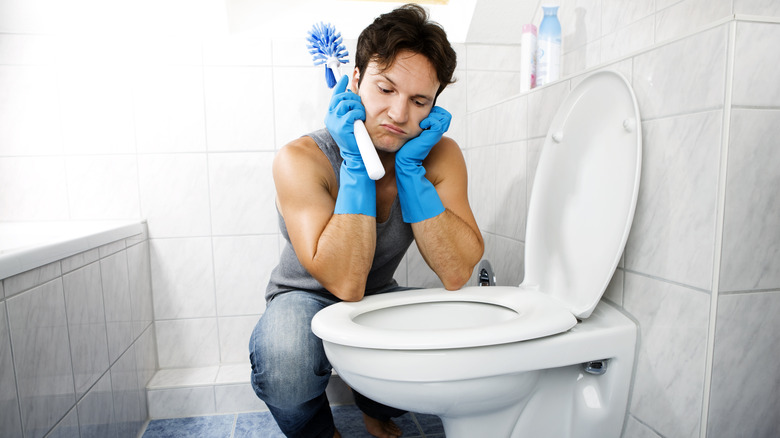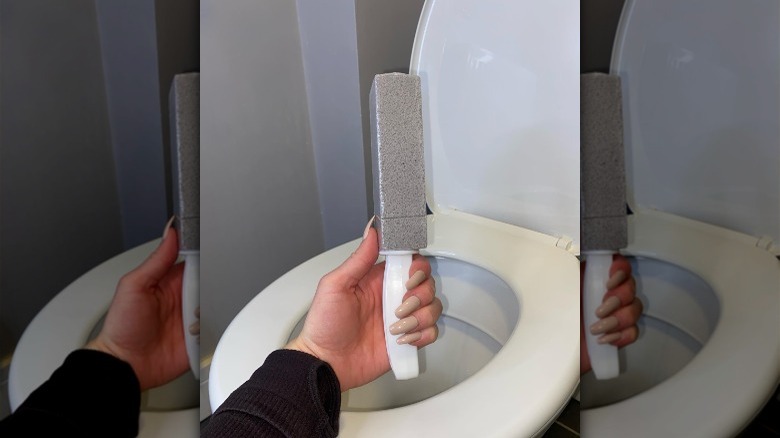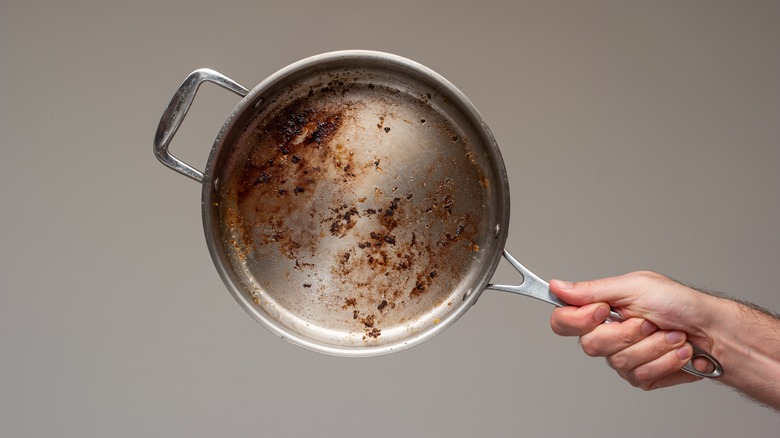A Pumice Stone Might Be The Secret To A Sparkling Clean Toilet
When it comes to keeping our homes spick and span, there's one area that often gets overlooked — the toilet. But fear not because there is a not-so-secret weapon that can transform your porcelain throne into a sparkling oasis. Enter the humble pumice stone. You might be familiar with this overlooked tool as part of your pedicure routine, but this porous rock holds the power to magically erase hard water and deeply ingrained stains from your toilet bowl. No longer will you need to generate embarrassing excuses or apologies to your guests about your stained toilet because your loo will look as good as new!
Since using a pumice stone has become a trendy hack in toilet cleaning, you can save the one in your pedicure kit for later and purchase one that comes with a long handle instead. The long handle is a great addition to the stone since it will eliminate the need to submerge your hand in the bowl, in turn minimizing the risk of touching contaminated toilet water. Still, protective gear should be worn when cleaning in the bathroom to reduce the risk of coming in contact with germs while disinfecting and cleaning.
Toilet restoration with a pumice stone
Pumice stones are formed from volcanic lava that has rapidly cooled and solidified, resulting in a porous and abrasive texture that makes them ideal for tackling tough stains. Unlike harsh chemical cleaners that often leave behind a pungent odor and negatively impact your plumbing and the environment, pumice stones are odorless and completely natural. These little wonders work like magic, effortlessly removing mineral deposits, hard water stains, rust, and even stubborn limescale from your toilet bowl. Simply wet the stone and gently scrub the stained areas, and watch as the pumice stone works its powers. While you scrub, the stone will begin to break down, and any deposits that shed into the bowl can safely be flushed away.
You might be wondering, won't a pumice stone scratch the toilet bowl? While it is indeed abrasive, it's surprisingly gentle on porcelain surfaces. As long as you use a wet stone and apply light pressure, the risk of scratching is minimal. Just remember to test it in an inconspicuous area first to ensure compatibility with your toilet bowl. Moreover, you'll want a long pair of cleaning gloves, goggles, and a mask to protect your skin and face from any unwanted sloshing over the sides of the bowl. Scrub up and scrub away to reveal your beautifully clean toilet bowl.
Other household objects you can clean with a pumice stone
Beyond the toilet bowl, a pumice stone can be a useful cleaning tool for other household items as well. Just be sure not to accidentally mix up the stone for the toilet and the stone for the kitchen. With its abrasive texture, a pumice stone can effectively remove tough, baked-on grease and food residue from grills and ovens. Simply wet it and gently scrub the surface, being careful not to apply too much pressure. The pumice stone will help to loosen and lift stubborn stains, leaving your oven or grill looking clean and fresh.
Pumice stones can also be used to clean the bottoms of pans and pots. Often, these cooking vessels can develop dark, burnt-on residue that is challenging to remove with regular cleaning methods. Again, with a wet pumice stone, gently scrub the affected areas in a circular motion, applying light pressure. The stone's texture will help to lift the burnt residue without scratching the surface.
Another household item that can benefit from the cleaning power of a pumice stone is a porcelain sink or bathtub. Over time, these surfaces can accumulate hard water stains, soap scum, and other deposits that regular cleaning may not fully remove. By wetting the pumice stone and gently scrubbing the stained areas, you can effectively eliminate these stubborn marks. Remember to always test the method first on a small, inconspicuous area to ensure no damage is done.


